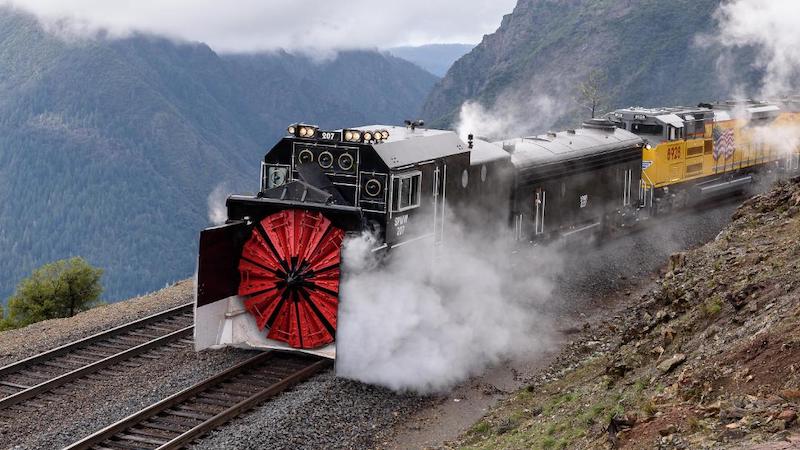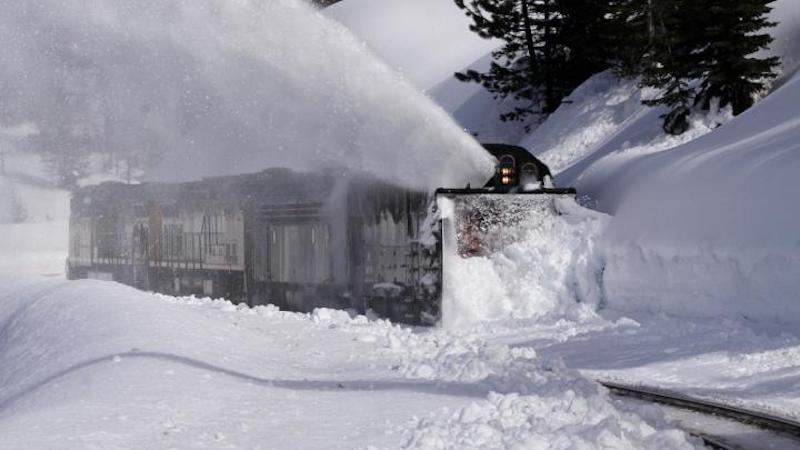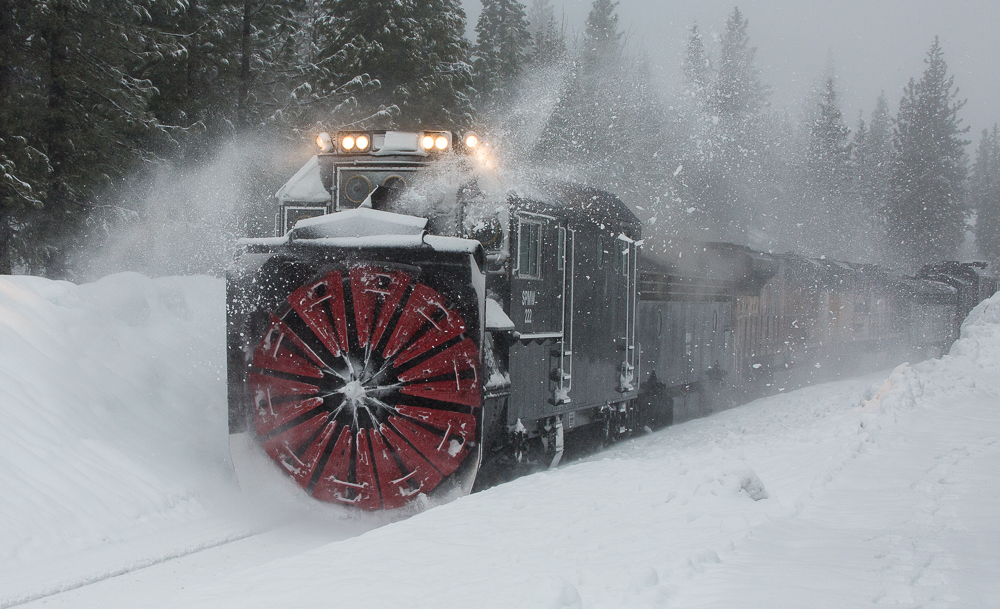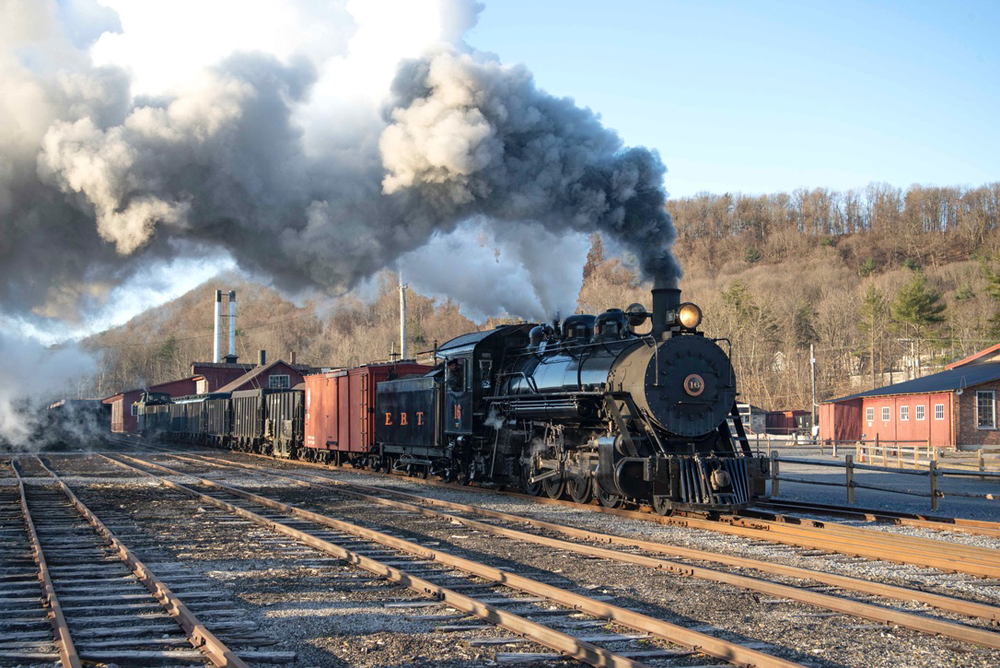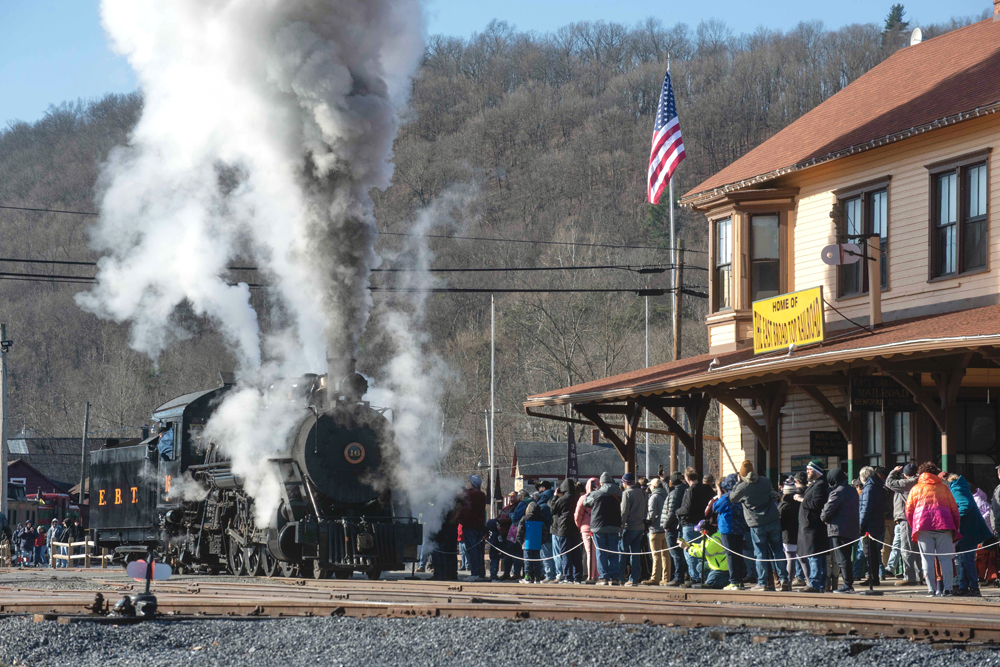Some very rare color photos, taken by an unknown photographer, of Southern Pacific's City Of Los Angeles when it was snowed in on Donner Pass on January 13th, 1952. The winter of 1952 was marked by a ton of storms off both the east and west coasts, causing a number of incidents with ships and airplanes. The City of Los Angeles, and the 236 people aboard, were also unfortunate enough to get caught up in the storms.
The jointly operated train departed Friday, January 11th over the Chicago & North Wester. All aboard confidently anticipated a Sunday arrival in Oakland before 9 a.m. There were 106 sleeping car passengers, and coaches carried another 90. Quite a few of them were scheduled to attend the Republican National Committee meeting to be held in San Francisco on Jan. 17, 1952. Others were servicemen returning to units due to sail from the West Coast after holiday leave. A few of the passengers were Midwesterners trying to escape the winter weather. Most of the passengers, however, were families with small children, returning home after holiday visits to relatives and friends in the Midwest. All were attended by a crew of 40.
The C&NW handled the train to Omaha (an agreement that would last until 1955, at which point UP changed the Chicago leg over to the Milwaukee Road due to complaints of C&NW service) and the Union Pacific then took the train to Ogden, Utah, with little issues. Southern Pacific took over at Ogden and the first sign of trouble was when they were delayed in Reno, which was experiencing its heaviest snowfall in 15 years. Eventually, the City of San Francisco edged out of town toward the Sierra, several hours behind schedule. It climbed the grade to Truckee paralleling U.S. 40 (now Interstate 80) and the Truckee River, and at Norden, just about the summit, the train was delayed again while SP section gangs and plow crews cleared the tracks ahead.
Moving again, they made it 13 miles west of Norden before drifting snow and a snow slide stalled the train. It was almost noon on Sunday, three hours after the train was due in Oakland. The train was close to U.S. 40, but that road was closed, accessible only to emergency snow vehicles of the power company. A parallel Southern Pacific track along the same right-of-way was unaffected by the slide, but those tracks were perched on an opposite slope. On Monday, the idling Alco PAs ran out of fuel and the heat and lights ceased and drifts began covering. the streamliner. As the water in the pipes froze, the toilets stopped up. The stoves in the dining car were separately fueled with charcoal, and were at least able to provide a source of hot soups and coffee, since the diner's water tanks didn't freeze.


Southern Pacific was aware that the City Of San Francisco was stuck and was trying to launch rescue efforts, but the winter conditions were hampering their work. A relief train from Reno was trying to follow the westbound track and breakthrough from behind but was making slow going. Another eastbound train from Roseville, California was blocked 35 miles from the stranded train by a derailed snowplow. The resources of the Sixth Army from the Presidio in San Francisco were enlisted and three M29 Weasels and their crews were placed on flat cars and sent east to the site of the rescue train. A section crew of about 30 Hispanic workmen, who had been clearing track before the train was stalled, were on site first and had aided the passengers and crew as much as they could. The section hands shoveled snow away from at least one window in every car to provide ventilation. They also kept a path to the mail car open. It served as the only entrance to the drift-covered train.




An outside group of rescuers arrived on skis from Soda Springs. They were led by a gentleman who went by Dennis Whiles, a ski instructor. The group brought 200 pounds of food, medicine and blankets. Dennis Whiles was actually Georg Gärtner, a German POW who had escaped from a POW camp in 1945 out of fear of repatriation to Germany and who had been on the FBI's most wanted list ever since. Ironically, Gärtner would end up being photographed by Life magazine as part of the rescue group and his photo would be published in the magazine. It wouldn't be until 1984 that he would go public about his true identity and would be allowed to stay in the US.
Southern Pacific Railroad Company managed to get a physician of its own to the site. Lawrence Nelson was dispatched from Truckee. He traveled by dog sled and snow tractor through 25-foot drifts to get to the train. He was welcomed by Walter H.L. Roehill, a physician from Middleton, Ohio, who had been en route to Honolulu. Roehill had been assisted by several military nurses who also were passengers. Roehill had his hands full and lacked medicine except for that in his small medical bag and what had been brought in by the first team from Soda Springs. When that team had made contact, it was clear that it would be some time before all passengers could be removed or the train itself moved. More outside parties broke through to the site with food and medicine, along with fuel for the stoves in the dining car.
Four servicemen took advantage of the comings and goings of outside rescue parties. They hitched a ride on a utility company tractor, then walked to the Nyack Lodge in Alta, CA. The 12-mile trip took five hours in visibility limited to 50 yards in daylight during the storm. Such conditions were braved by a San Francisco Chronicle reporter, Art Hoppe, and a photographer. Although both had been on skis before, they were not exactly experts at the sport. They managed to reach the train though, and Hoppe interviewed passengers and crew, then returned to the Nyack Lodge with one of the relief parties to file his story by telephone. His exclusive made the front page. The photographer remained overnight taking pictures. He subsequently had another front-page story and a feature spread.

By Wednesday, January 16th, the fourth day of the ordeal, the snow had stopped and the sky was clear and sunny. A snowplow had cleared U.S. 40 from the Nyack Lodge to Yuba Gap. A convoy of passenger cars and trucks had been organized at Nyack Lodge. A Southern Pacific special rescue train was able to make it as far east as Emigrant Gap. There, eight Pullman cars, two dining cars, a club car and a coach awaited the stranded passengers. Pershing Jay Gold drove the first snowcat to reach the train and evacuated the first four passengers. He died of a heart attack less than a week after the rescue, becoming the second fatality of the disaster. The first had been Roland R. Raymond, an engineer with Southern Pacific, who had had his rotary snowplow stall on the tracks as he pushed east toward the train, trying to clear the track. He stepped out of his cab and was standing alongside the plow when an avalanche swept him away.
The passengers had to walk to U.S. 40 at Yuba Gap, a distance of about a half-mile. Six litter cases were carried to the waiting convoy of cars and trucks. Once in the vehicles, the survivors were taken five miles on the cleared highway to Nyack Lodge. There, they rested while the baggage and mail were brought from the train for transport to Oakland. Almost 81 hours after their ordeal had begun on Sunday, January, 13, the 196 passengers and 40 crewmen climbed aboard the relief train at Emigrant Gap. Steaks and fried chicken were provided. For people whose last decent meal had been breakfast three days before, it was most welcome. Another relief was being able to smoke again within the train. Smoking in the stranded streamliner had been banned lest the small amount of ventilation be fouled. At 3:30am on Thursday, January 17th, the saga of The City of San Francisco came to an end. The passengers arrived at Oakland to be met by loved ones and a host of newsmen. As a footnote, on Saturday, January 19th, the train itself was finally retrieved off of Donner Pass and was dragged to a yard for repair.



















